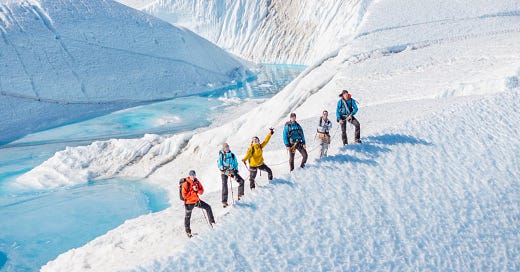GO OUTSIDE #21: Life Lessons from the Most Remote Ecosystem on Earth
Have you been outside today?
Climate Report:
If you’re feeling whiplash between arctic storms and sunny skies like we are here in New York, you’re not alone… Migratory birds are feeling it too. In Chicago, springtime birds are appearing in February - some expected, some reflecting shifting migration patterns as overall temperatures warm.
Founders Intro:
Hi Stewards,
Try this icebreaker question the next time you’re with a group: if you could choose one ecosystem to vacation for the rest of your life, where would it be?
The most predictable answers lean toward the ocean or chaparral where the Mediterranean resides or the temperate forest if you’re into hiking. These days, I would say the polar desert and tundra. These are two ecosystems that make up the most remote continent on earth, also known as Antarctica (and no, there are no polar bears here, only penguins).
This polar region is 98% covered in ice and roughly twice the size of Australia. At the end of January, I experienced this remote ecosystem firsthand with a tour operator called White Desert Antarctica, founded and led by polar explorer and world record holder Patrick Woodhead.
Here are three life lessons I learned while living on million-year-old ice for a week:
Social constructs are arbitrary. As soon as you step on this continent, your national identity, political identity and other constructs such as urgency or a 24 hour news cycle simply evaporate. In a place without time zones, sunsets for an entire season, or cellular service, you have no choice but to surrender to the stillness and oneness of Mother Nature.
Eco system > Ego system. Life on earth is a goddamn miracle, we must protect it. When face to face with untouched wilderness, you really feel so humbled and grateful to share this earth with Mother Nature. We need climate solutions that work in harmony with nature, not solutions that continue to conquer nature or put humanity above other nature.
Everything is interconnected. The ice shelf is around a 100km chunk of ice that is attached to the landmass of Antarctica. Scientists are studying the rate at which this is melting and how this will cause ripple effects of sea levels rising that will affect us all. Scientists have also discovered that microplastics have already made their way into the ice in Antarctica, our plastic pollution now impacting areas where there has never been human activity.
In order to continue protecting the largest wilderness on Earth, here are five initiatives White Desert Antarctica utilizes to minimize their impact:
1. Fly using sustainable aviation fuel
2. Carbon offset remaining emissions with nature-based solutions (White Desert has partnered with Project Seagrass, allowing them to be carbon neutral since 2007)
3. Use solar energy (the sun doesn’t set for half the year, and cooler temperatures help solar panels run more efficiently)
4. Have a low-impact supply chain that eliminates single-use plastic and incorporates responsible waste disposal (crucial as there is no waste system in Antarctica, each of the pop-up camps are designed to be completely dismantled at the end of the season so there is no trace left on the landscape)
5. Support and contribute back to the local scientific and Antarctic community (White Desert brings around 200 scientists every season to their research centers while sharing other logistics like crevasse mapping)
You don’t have to travel all the way to Antarctica to feel humbled and connected to the oneness of nature. This connection is our birthright, accessibility should be the baseline and we shouldn’t have to convince the people and systems in power to question its value. But alas, we steward on…
One World,
Steward Sophia
What’s going on in Climate 3.0?
White Desert launched the White Desert Earth Foundation, their research and nonprofit initiative exploring scalable climate tech solutions and supporting carbon sequestration through seagrass replantation in Cape Town. If it can work in Antarctica, can it work anywhere?
Steward Spotlight:
Saad Amer is a multi-hyphenate climate activist and founder of Justice Environment, a climate impact consultancy helping businesses, nonprofits, and governmental organizations transition towards a just and sustainable future. Championing the power of democracy, he has mobilized millions of youth and BIPOC to vote on issues like climate change, social justice, and voting rights.
Lucky links:
Follow us on instagram, threads, twitter, linkedin & check out our website
Want to become a STEWARD?
1. have a digital wallet (step-by-step guide)
2. join and share this Substack community
3. buy a piece of digital art in our second mint wave, open now!






